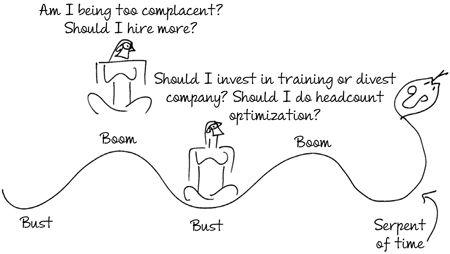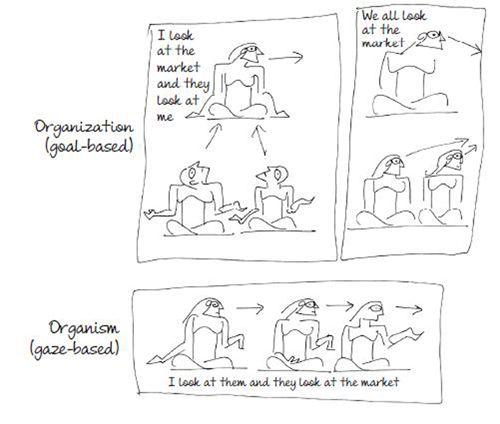Business Sutra: A Very Indian Approach to Management (29 page)
Read Business Sutra: A Very Indian Approach to Management Online
Authors: Devdutt Pattanaik

Navin started his career as a sales representative in a consumer goods company. He resented the marketing guys who sat in air-conditioned rooms all day poring over quantitative and qualitative market research data. He resented the fact that they were paid more while it was he who got in the revenue. He carries this resentment till date. Now he is the CEO of a retail chain. He spends all his time with his sales team and the guys on the frontline. He is impatient with his marketing team, tells them repeatedly to go and spend time in shops with the customers. As a result, the marketing team has become tactical about today's sales and this quarter's targets. No one in the company is thinking strategically. The CEO is meeting today's numbers and is not prepared for tomorrow's challenges. This does not bode well for the organization as a whole, or for Navin's career, because he has no one thinking ahead. This is what happens when one wife/brother/son gets more value than the opposing but balancing force.
The impact of an organizational decision is different depending on the source
In the scriptures, different beings live in different spheres. At the lowermost level are the humans. Above them are the devas or gods, led by Indra. Above Indra is Brahma and above him is Vishnu. Shiva is above Vishnu and the Goddess is above Shiva. It is said that when Indra blinks a human dies; every time Brahma blinks, an Indra dies; every time a Vishnu blinks, a Brahma dies; every time a Shiva blinks, a Vishnu dies; and every time the Goddess blinks, a Shiva dies. Thus, the notion of time differs at different levels. And the impact of blinking varies depending on who is blinking.
Organizations, too, have a similar hierarchy in place. At the top sits the CEO, below him sit many unit heads under whom are many managers who have many executives under them. Each one's 'blink' has a different impact on the market.
A leader has to realize two things with regard to this blinking. The first is related to the time-impact of his blink: it takes time for his decision to reach the periphery of his organization, that is, the frontline where people engage with the marketplace. This demands patience. The second is the space-impact of the blink: what seems like a simple decision for the leader has to manifest itself multiple times in the rest of the team. In other words, it has to be understood by many Brahmas. The impact of any error is huge. This makes the cost of an error huge. Large organizations are uncomfortable with such impacts. This is why they control the rate of decisions made upstream in the management chain. Unfortunately, this prevents large organizations from being nimble.
Further, in many organizations it is not clear who is the head. For example, in the Shiva Puran, Kailas is above Vaikuntha whereas in the Vishnu Puran, Vaikuntha is above Kailas. And not everyone agrees that the abode of the Goddess is supreme. And so, people get confused as to who is blinking and who is staring.

Gyanesh has still not realized the power of blinking. He is currently the head of a 800-strong sales force. Fifteen years ago, he was a salesman renowned for getting things done rapidly. He would take quick decisions and get things done. Owing to this ability, he was very popular in the market and a successful salesman. Fifteen years later, he is still restless and continues to make decisions on the spur of the moment. What he does not realize is that the decisions he makes impact the lives of 800 sales people located across the country. The impact is huge though the time taken for it to show is much longer. By the time everyone in the field understands a decision two months have passed. And by the time they implement the decision, they learn that Gyanesh has changed his mind once again.
In a shifting world, organizations need to be organisms
In the Rig Veda, the organization is described as purush, an outpouring of imagination, an organism. In Jain chronicles, the world is seen as being constantly volatile. It is never stable and is seen as a slithering serpent or sarpa that alternates between an upward boom (sushama) and bust (dushama). Our mind, too, constantly wavers from an optimistic gaze (utasarpini) to a pessimistic gaze (avasarpini), depending on resource availability and market response. With such a view of markets, organizations perforce need to be nimble; they need to be organisms.
The difference between an organization and an organism is that the organization is a thing that is insensitive to the world around it, while an organism is a living being that is aware of the world around it. The organization is a set of rules that people follow whereas the organism is a set of people who follow rules.
Organizations work well when the world around them is stable and predictable. But when the world is unstable, or the market is volatile because of political, economic and regulatory reasons, or because of the changing tastes of the consumer, the organization has to be super-sensitive and adaptable. It needs to be like an organism.
Organizations are of value when one deals with a single market. Organisms are needed when one has to deal with multiple markets. It may be a good time in one market but a bad time in another. In such cases, a global strategy does not help. One needs local strategies. That is why most Indian villages have a local village-god or grama-devata who is linked to the grand, cosmic distant and abstract bhagavan, who oversees everything. The gramadevata knows how to translate the global view to local conditions. Crisis in a particular village may not affect the whole organization, but it does matter to that particular village. The bhagavan may not give the village as much time and attention as the grama-devata would.
Most villages even have matrix structures in that there is the grama-devata who looks at problems within the context of the village, and the kula-devata who looks at the problem within the context of a particular community that is spread across many villages. Since both the grama-devata and kula-devata are the local communities' manifestations of the global bhagavan, there is enough trust and understanding not to lead to conflict or demands for consensus.
It was a crazy idea but it worked. When Lalwani became the head of the firm, he observed that every department was a silo working in isolation. His leadership team was hardly a team but a bunch of people in the room with no connection to each other. Each of them was focusing on their individual key result area and ignoring the impact on others. So Lalwani came up with an idea. Every six months, the head of a department would make a presentation on the performance of another department and answer questions as if s/he were the head of that department. For instance, Randhir, who headed finance, would make the marketing presentation and Piyush who headed sales would make the human resource presentation. Departments were chosen by lots and to make the exercise serious, it was given a weightage of 20 per cent in the appraisal. Suddenly, everyone was talking to each other. Randhir had to understand marketing, Piyush had to understand human resources. The silos were ruthlessly broken. After much initial discomfort, people started empathizing with each other. The organization became an organism.

In an organism, individual potential and context are taken into consideration
In an organization, the centre takes decisions and those at the periphery follow. In an organism, people downstream (at the periphery) are as sensitive, proactive and responsible as the people upstream (at the centre). For an organization to become an organism, people need to understand both the universal as well as the particular. Everyone needs to see the big picture along with their context specific roles.
Inherent in the word 'leader' is that one who is so decides which direction everyone should go and the rest follow. Yet the leader is located in Kailas, far from the marketplace. His vision is wider, but lacks the local insight that comes from Kashi. Should his garud-drishti take precedence over sarpa-drishti?
To complement the leader's view, everyone else ought to look at the marketplace and then reach a consensus. This is teamwork preventing the autocracy of the leader. However, the people at different rungs of the organizational hierarchy do not have the same gaze, motivations, drive, or even the same line of sight. They will see different things. The eagle will end up fighting the snake and neither will win, except the most powerful, the one with the loudest voice, the one most favoured by the shareholder.
In an organism, every yajaman looks at the devata, and encourages the devata to do the same. Every yajaman clarifies who his immediate team of graha is and who the distant team of tara is. The yajaman works to evoke the potential of his devata and helps him deal with his context so that he delivers. The cascade creates an organism.
To become an organism, an organization has to try to emulate the perfection of the human body. Each of the trillions of body cells that make up our body is sensitive to the big picture as well as the local picture. All of them have the same DNA, but each of them produces only those proteins needed in their location. The eye cell has the same DNA as the skin cell, yet both are structurally and functionally very different, as demanded by their local roles. Every cell is sensitive to the world around itself. Each cell knows that the excessive growth of one at the cost of another is cancer, which will destroy the whole organism, while suboptimal growth is degeneration and death.
Akhilesh's call centre appeared from nowhere and became a major competitor in the industry. What was the reason behind its success? Akhilesh said, "We have strict rules and systems that have to be followed by every manager. But we also have a bypass system that allows the local manager to take quick local decisions without consulting the central business unit head. The centre can in no way predict what will happen in different markets at different points of time. Every client's needs are unique and so we need to have flexible systems, which is rather ironical, as systems are meant to standardize and minimize deviations. The bypass routes make us nimble and also build trust. We do not treat those in the periphery as answerable to the centre; they are answerable to their own balance sheets. For me every employee is a manager and a leader from the first day itself. Only their contexts are small."

Organisms thrive when the yajaman is flexible
In an organization with Kamas and Yamas, devas and asuras, Brihaspatis and Shukras, garuds and sarpas, Kailas and Kashi, various constellations and planets, there is a need for liminal beings.
Liminal beings are creatures that belong in-between, neither here nor there, but on the threshold. A liminal being is a translator, an intermediary. They enable smooth transactions between different categories, as they are able to see each problem from everyone's point of view and the impact of each decision on various sections of the organization.
Ganesha is one such liminal being. He has the head of an elephant and body of a human, thus he stands at the threshold of the animal and human world. He understands animal fears which ensure survival over millions of years. At the same time, he also understands human imagination that can help us outgrow our fears, take risks, explore unfamiliar realms and create new possibilities.
